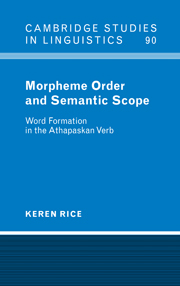Book contents
- Frontmatter
- Contents
- Preface
- 1 Introduction: Beginning the Journey
- PART I FIRST STEPS
- PART II THE LEXICAL ITEMS
- PART III THE FUNCTIONAL ITEMS
- PART IV A VIEW OF THE LEXICON
- 14 The Scope Hypothesis and Simplifying the Lexicon
- 15 Evidence from the Lexicon
- PART V THE END OF THE JOURNEY
- PART VI APPENDIXES
- Notes
- References
- Name Index
- Languages Index
- Subject Index
14 - The Scope Hypothesis and Simplifying the Lexicon
Published online by Cambridge University Press: 06 July 2010
- Frontmatter
- Contents
- Preface
- 1 Introduction: Beginning the Journey
- PART I FIRST STEPS
- PART II THE LEXICAL ITEMS
- PART III THE FUNCTIONAL ITEMS
- PART IV A VIEW OF THE LEXICON
- 14 The Scope Hypothesis and Simplifying the Lexicon
- 15 Evidence from the Lexicon
- PART V THE END OF THE JOURNEY
- PART VI APPENDIXES
- Notes
- References
- Name Index
- Languages Index
- Subject Index
Summary
I have argued that the verb in Athapaskan languages illustrates a close mirroring between function and structure, with the largest disruption in this functionally determined ordering coming in the surface position of the verb stem and voice/valence. In this chapter I review the types of cases that argue for the scope principle and consider consequences of this principle for the lexicon.
Recall the predictions of the scope hypothesis from Part I.
(1) a. The ordering of elements is fixed when the scopal relationship between them is fixed.
b. The ordering of elements may be variable when there is no scopal relationship between those elements.
c. The ordering of elements is variable when the scopal relationship between them is not fixed.
First consider the claim that ordering is fixed when the scopal relation between elements is fixed. This has been shown in several ways. For example, the relationship among participant subject, viewpoint aspect, situation aspect, and object agreement/number is fixed across the family, and I have argued that this ordering is predicted by the scope hypothesis. As another example, preverbs occur in a fixed position with respect to quantifiers and incorporates, again as predicted by the scopal ordering hypothesis.
The second claim is that ordering may be variable when no scopal relationship exists between elements. We have seen several cases of variable ordering. Noun class markers do not interact and occur in variable order across the family.
- Type
- Chapter
- Information
- Morpheme Order and Semantic ScopeWord Formation in the Athapaskan Verb, pp. 369 - 372Publisher: Cambridge University PressPrint publication year: 2000

